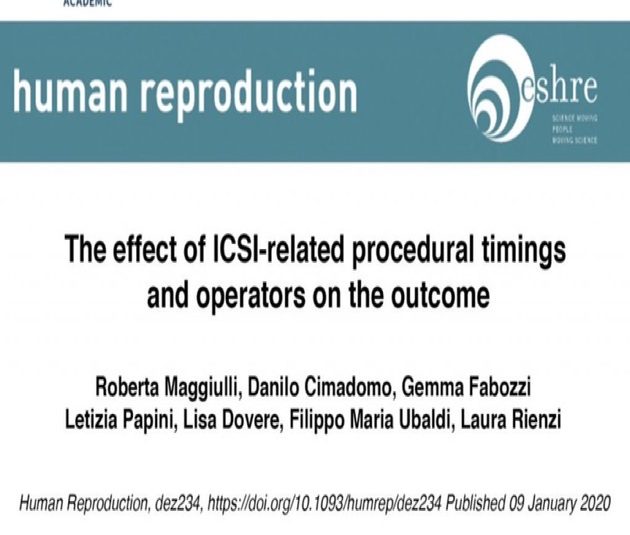
The effect of ICSI-related procedural timings and operators on the outcome
Roberta Maggiulli, Danilo Cimadomo, Gemma Fabozzi, Letizia Papini, Lisa Dovere, Filippo Maria Ubaldi, Laura Rienzi
Human Reproduction dez234, https://doi.org/10.1093/humrep/dez234, Received 08 April 2019; Revision received: 11 September 2019; Revision requested: 01 October 2019; Published 09 January 2020
Abstract
STUDY QUESTION
Do the ICSI-related procedural timings and operators affect the outcomes of an ART cycle?
SUMMARY ANSWER
The ICSI-related timings and operators do not associate with the mean blastulation rate per cohort of inseminated oocytes and the cumulative delivery rate per concluded cycle, except for a mild association between the times from induction of ovulation to oocyte denudation and the former outcome
WHAT IS KNOWN ALREADY
In ART, specific timings, protocols and conditions must be complied with to preserve gamete developmental and reproductive competence during the required manipulations. ICSI represents a groundbreaking advancement that has been widely implemented. Nevertheless, the studies that examined the putative impact of ICSI-related procedural timings were mainly conducted in old-fashioned settings or in good prognosis patients. No report addressed issues like operators’ skills and experience and uncertainties exist dealing with the effect of cumulus cells in the pre-incubation period in vitro before ICSI. However, all this information is crucial to efficiently plan the daily routine of an IVF lab, fill the existing gaps of knowledge and define proper key performance indicators
STUDY DESIGN, SIZE, DURATION
Observational study conducted at a private IVF clinic (January 2016 to January 2018). We included all consecutive ICSI procedures (n = 1084 infertile couples undergoing 1444 cycles with or without preimplantation genetic testing (PGT); mean ± SD maternal age: 38.1 ± 4.0 years) with fresh autologous oocytes (n = 7999 oocytes, 5.5 ± 3.2 per treatment) inseminated with fresh non-donor ejaculated sperm. All operators and critical procedural timings (induction of ovulation to oocyte denudation, denudation and ICSI) were automatically recorded through an electronic witnessing system. The primary outcome measure was the cumulative delivery rate among both non-PGT and PGT-concluded cycles (i.e. delivery achieved or no supernumerary cryopreserved blastocyst available). The secondary outcome measure was the mean blastulation rate per cohort of inseminated oocytes. All confounders were registered and included in generalized linear models and multivariate logistic regression analyses
PARTICIPANTS/MATERIALS, SETTING, METHODS
Fourteen and 12 operators were involved in denudation and ICSI procedures, respectively. Denudation was performed after 4.1 ± 1.2 h (2–7) of pre-incubation in vitro after oocyte retrieval, and ICSI was started immediately after. Beyond procedural timings and operators, all the putative confounders (patients’ and cycles’ characteristics) on the primary and/or secondary outcomes were systematically registered and included in the statistical analyses
MAIN RESULTS AND THE ROLE OF CHANCE
The mean time from induction of ovulation to oocyte denudation was 39.3 ± 1.3 h. The mean procedural timings for denudation and ICSI were 8.1 ± 3.8 and 12.6 ± 6.4 min; both these variables were significantly dependent on the number of inseminated oocytes and the operators’ skills and experience. The overall mean blastulation rate per cohort of inseminated oocytes was 34.0 ± 27.9%. This outcome was significantly associated with the time from induction of ovulation to oocyte denudation (mean blastulation rate stable in the time interval 38–42 h, but significantly higher for timings <38 h), maternal age (the mean blastulation rate drops especially beyond the age of 40 years) and categorized sperm concentration (highest mean blastulation rate for sperm concentrations ≥15 mil/ml and lowest for cryptozoospermic patients) through a generalized linear model that showed an adjusted r2 = 0.053 (P < 0.01). No association was found for denudation and ICSI timings and operators. Lastly, when adjusted for maternal age and number of inseminated oocytes, both ICSI-related procedural timings and operators did not associate with the cumulative delivery rate among both non-PGT- or PGT-concluded cycles
LIMITATIONS, REASONS FOR CAUTION
This is a single private IVF center study. Its reproducibility should be assessed in different laboratory conditions, with different protocols and in the hands of different operators. Moreover, specific studies are warranted to address the beneficial/detrimental effect of the other putative confounders under investigation (e.g. kind of ovulation trigger, culture media, incubator, etc.)
WIDER IMPLICATIONS OF THE FINDINGS
Proactive communication between the embryologists and the clinicians might contribute to a reasoned and more efficient organization of the daily workload and increase the mean blastulation rate, especially when poor prognosis couples (advanced maternal age, reduced sperm count and/or ovarian reserve) are treated
STUDY FUNDING/COMPETING INTEREST(S)
No funding. The authors declare no conflict of interest related to the present study
Keywords: oocyte metaphase II rate, oocyte denudation, ICSI timings, live birth, blastocyst, electronic witnessing system, IVF quality control, induction of ovulation